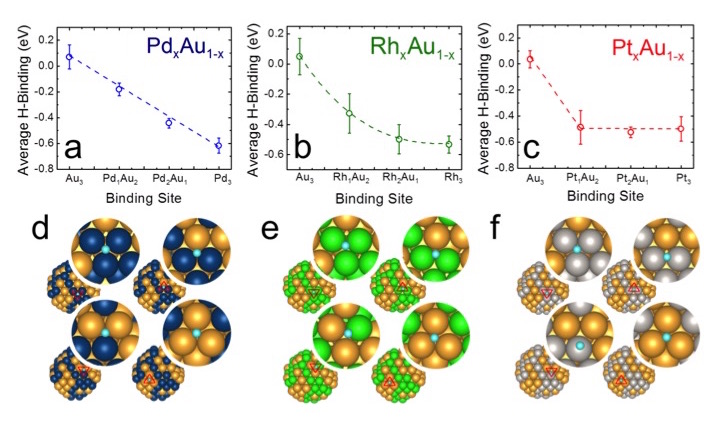Materials for Fuel-cell catalysts
In this project, you will have the opportunity to investigate new materials for potential catalyst in fuel cells and Li-Air batteries. To predict catalytic activity for reactions that occur in alternative energy resources, you can calculate the binding energy of key intermediates such as oxygen for the oxygen reduction reaction or hydrogen for the hydrogen evolution reaction. FRI students have created a database of binding energies on bimetallic materials and explored how the composition of a binding site (or ensemble effect) effects catalytic activity or binding energies. You can explore this database by clicking here. You can also explore the core/shell database by clicking here. They have found several trends in compositions of the binding site for bimetallics for various adsorbates (See below), though the majority of materials were found to be linear (or what we call tunable!). FRI students were also able to pull out promising material candidates for catalysis from this database.

Binding energy can also be affected by the site location. So far we have only looked at facet sites. Edge and corner sites have different properties and are worth investigating in the future.

Literature serach
-
People: Abigail
We need a stable nanoparticle structure with around 79 atoms for the following crystal structures: BCC, HCP.
This will enable us to investigate more elements. Start with Google scholar or UT Library are both good ideas.
-
We need to find a way to include BCC and HCP metals in our nanoparticle or slabs.
Our nanoparticle and slabs are created based on the FCC lattice. Mixing a substantial amount of BCC or HCP metals in can destablize the structure and make our results hard to use.
We need to find precedences how people have been overcoming this issue. Both Google Scholar and the UT Library are good places to start.
Data processing
-
People: Teressa, Qianyu, Caroline.
We need to create code that can do LASSO regression on our FRI cluster.
Jesus created a script with Jupyter note book, which uses uploaded from his local computer. We need to transfer this to our FRI cluster. The code has been copied to /home/fri/projects/fuelcell/lasso.ipynb.
To get started, we need to first have a better understanding of how the script works. Find all dependencies it has that FRI doesn't have and document those.
Document every function that you can't know immediately its purpose from simply reading the code. Briefly describe what the function does, and provide a link to its documentation page.
Lastly, create a working python script to run LASSO regression on FRI.
-
People: Karan
We need a script that can process preliminary data from the expanded bimetallic calculations.
Our bimetallic database with only 50/50 composition has been updated here: /home/jam26734/Updated_DB
The data contained within are processed by 2 scripts: jsonupdater_angelo.py and calculations_angelo.py
We first need to be able to screen through the database and see if we have data for every esemble at every composition, and find out missing ones. This can be done by either creating a new script or add it to one of the existing ones.
Then we need to find ways to process the expanded database at /home/jam26734/CompositionsDB/database2468
It's a good idea to start by trying to find ways to use existing scripts mentioned above to process new data here.

